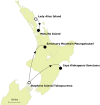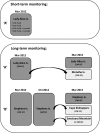Moving house: long-term dynamics of corticosterone secretion are unaltered in translocated populations of a rare reptile (the tuatara, Sphenodon punctatus)
- PMID: 27293699
- PMCID: PMC4778483
- DOI: 10.1093/conphys/cov014
Moving house: long-term dynamics of corticosterone secretion are unaltered in translocated populations of a rare reptile (the tuatara, Sphenodon punctatus)
Abstract
Translocations are an important conservation tool used to restore at-risk species to their historical range. Unavoidable procedures during translocations, such as habitat disturbance, capture, handling, processing, captivity, transport and release to a novel environment, have the potential to be stressful for most species. In this study, we examined acute and chronic stress (through the measurement of the glucocorticoid corticosterone) in a rare reptile (the tuatara, Sphenodon punctatus). We found that: (i) the acute corticosterone response remains elevated during the initial translocation process but is not amplified by cumulative stressors; and (ii) the long-term dynamics of corticosterone secretion are similar in translocated and source populations. Taken together, our results show that translocated tuatara are generally resistant to cumulative acute stressors and show no hormonal sign of chronic stress. Translocation efforts in tuatara afford the potential to reduce extinction risk and restore natural ecosystems.
Keywords: Corticosterone; reptile; stress; translocation; tuatara.
Figures





References
-
- Adams NJ, Parker KA, Cockrem JF, Brunton DH, Candy EJ. (2013) Inter-island differences in the corticosterone responses of North Island Saddlebacks (Philesturnus rufusater) in New Zealand do not suggest selective effects of translocation. Emu 113: 45–51.
-
- Almasi B, Roulin A, Jenni L. (2013) Corticosterone shifts reproductive behaviour towards self-maintenance in the barn owl and is linked to melanin-based coloration in females. Horm Behav 64: 161–171. - PubMed
-
- Anderson L, Cree A, Towns D, Nelson N. (2014) Modulation of corticosterone secretion in tuatara (Sphenodon punctatus): evidence of a dampened stress response in gravid females. Gen Comp Endocrinol 201: 45–52. - PubMed
-
- Armstrong DP, Seddon PJ. (2008) Directions in reintroduction biology. Trends Ecol Evol 23: 20–25. - PubMed
-
- Baker MR, Gobush KS, Vynne CH. (2013) Review of factors influencing stress hormones in fish and wildlife. J Nat Conserv 21: 309–318.
LinkOut - more resources
Full Text Sources
Other Literature Sources

